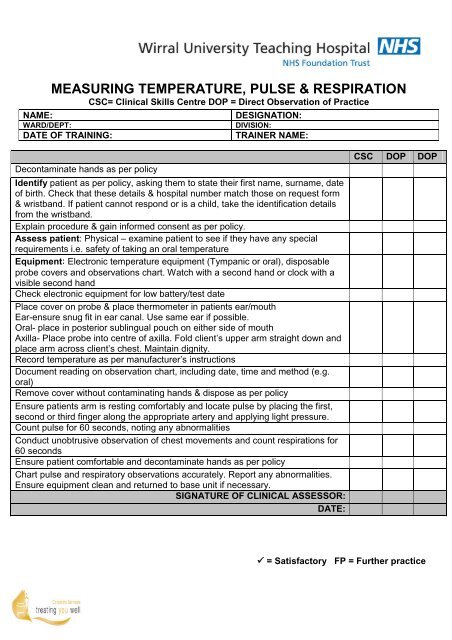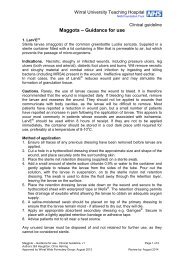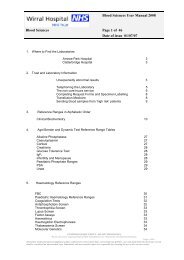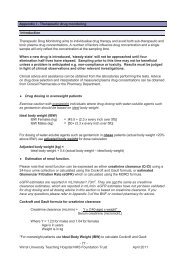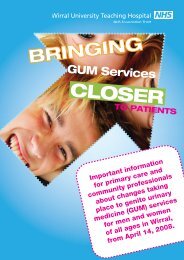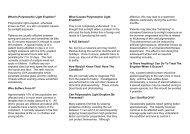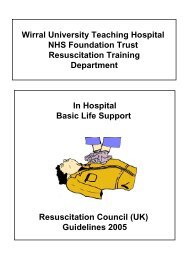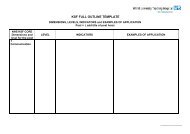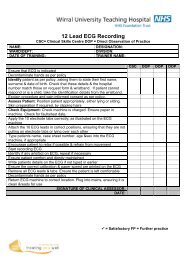Measuring Temperature, Pulse and Respiration
Measuring Temperature, Pulse and Respiration
Measuring Temperature, Pulse and Respiration
You also want an ePaper? Increase the reach of your titles
YUMPU automatically turns print PDFs into web optimized ePapers that Google loves.
NAME:WARD/DEPT:MEASURING TEMPERATURE, PULSE & RESPIRATIONCSC= Clinical Skills Centre DOP = Direct Observation of PracticeDATE OF TRAINING:DESIGNATION:DIVISION:TRAINER NAME:Decontaminate h<strong>and</strong>s as per policyIdentify patient as per policy, asking them to state their first name, surname, dateof birth. Check that these details & hospital number match those on request form& wristb<strong>and</strong>. If patient cannot respond or is a child, take the identification detailsfrom the wristb<strong>and</strong>.Explain procedure & gain informed consent as per policy.Assess patient: Physical – examine patient to see if they have any specialrequirements i.e. safety of taking an oral temperatureEquipment: Electronic temperature equipment (Tympanic or oral), disposableprobe covers <strong>and</strong> observations chart. Watch with a second h<strong>and</strong> or clock with avisible second h<strong>and</strong>Check electronic equipment for low battery/test datePlace cover on probe & place thermometer in patients ear/mouthEar-ensure snug fit in ear canal. Use same ear if possible.Oral- place in posterior sublingual pouch on either side of mouthAxilla- Place probe into centre of axilla. Fold client’s upper arm straight down <strong>and</strong>place arm across client’s chest. Maintain dignity.Record temperature as per manufacturer’s instructionsDocument reading on observation chart, including date, time <strong>and</strong> method (e.g.oral)Remove cover without contaminating h<strong>and</strong>s & dispose as per policyEnsure patients arm is resting comfortably <strong>and</strong> locate pulse by placing the first,second or third finger along the appropriate artery <strong>and</strong> applying light pressure.Count pulse for 60 seconds, noting any abnormalitiesConduct unobtrusive observation of chest movements <strong>and</strong> count respirations for60 secondsEnsure patient comfortable <strong>and</strong> decontaminate h<strong>and</strong>s as per policyChart pulse <strong>and</strong> respiratory observations accurately. Report any abnormalities.Ensure equipment clean <strong>and</strong> returned to base unit if necessary.SIGNATURE OF CLINICAL ASSESSOR:DATE:CSC DOP DOP = Satisfactory FP = Further practice
KNOWLEDGE ASSESSMENT CSC DOP DOP DOPWhat is a normal temperature range?What is the normal adult pulse range?What is the normal respiration rate range?How soon after a hot drink should you wait before recording an oraltemperature?CANDIDATE’S STATEMENT OF VERIFICATIONI have successfully undertaken a period of supervised practice & have achieved all of thecomponents in the assessment tool. I underst<strong>and</strong> that it is my professional responsibility toadhere to relevant policies & procedure guidelines when undertaking this skill in accordancewith guidance from professional bodies & Dept. of Health. I underst<strong>and</strong> that I may be auditedto monitor effectiveness of training provided.Signature:C<strong>and</strong>idateSignature:AssessorDate achieved:Date achieved:NB: Signature of assessor in practice if new to skill or signature ofClinical Skills assessor if updateReferences & Links to policiesNursing Times.net 26 th February 2008 Patient assessment Part 2-<strong>Measuring</strong> Oral<strong>Temperature</strong>Royal Marsden (2006) Clinical Nursing Procedures. Intranet version (6 th Edition)WUTH Policies - Consent to Treatment, Identification of Patients, H<strong>and</strong> Hygiene.Clinical Competency <strong>Measuring</strong> temperature, pulse & respiration January 2011 Review 2012


